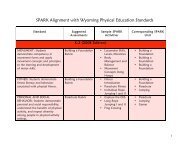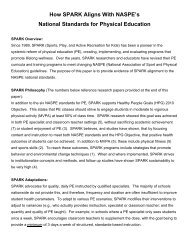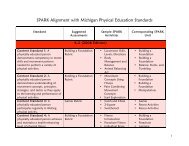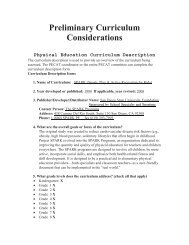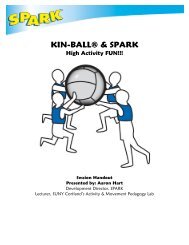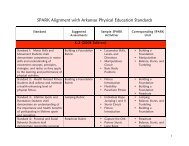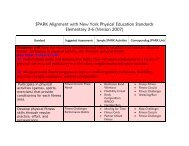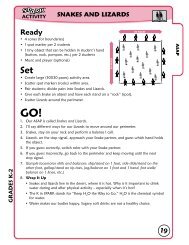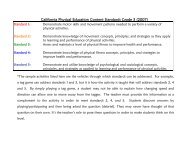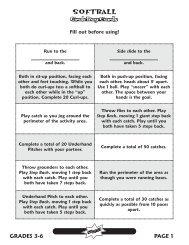California Physical Education Content Standards Grade 6
California Physical Education Content Standards Grade 6
California Physical Education Content Standards Grade 6
You also want an ePaper? Increase the reach of your titles
YUMPU automatically turns print PDFs into web optimized ePapers that Google loves.
Standard 1:Standard 2:Standard 3:Standard 4:Standard 5:<strong>California</strong> <strong>Physical</strong> <strong>Education</strong> <strong>Content</strong> <strong>Standards</strong> <strong>Grade</strong> 7Demonstrate motor skills and movement patterns needed to perform a variety ofphysical activities.Demonstrate knowledge of movement concepts, principles, and strategies as they applyto learning and performance of physical activities.Assess and maintain a level of physical fitness to improve health and performance.Demonstrate knowledge of physical fitness concepts, principles, and strategies toimprove health and performance.Demonstrate and utilize knowledge of psychological and sociological concepts,principles, and strategies as applied to learning and performance of physical activities.*The sample activities listed here are the vehicles through which standards can be addressed. For example,a tag game can address standards 1 and 3, but it is how the activity is taught that will address standards 2, 4and 5. By simply playing a tag game, a student may not be able to explain how changing speed anddirection can allow one to move away from the tagger. The teacher must provide this information as acomplement to the activity in order to meet standards 2, 4, and 5. Students discover answers byplaying/participating and then being asked the question (debrief). They may never have thought of thatquestion on their own. It’s the teacher’s role to pose these questions in order to make students think on thislevel.
<strong>Content</strong> <strong>Standards</strong> Assessment Strategies Sample Activities UnitStandard 1Demonstrate motor skills and movement patterns needed to perform a variety of physical activities.1.1 Demonstrate mature techniques Standard 1:• Five-Person Throw • Softballfor the following patterns:overhand, sidearm, and underhandTeacher Observation Checklists:Performanceand Run Softball• Small Sided Soccer • Soccerthrowing; catching;Peer Assessment• Keep It Up• Volleyballkicking/punting; striking; trapping;dribbling (hand and foot); andvolleying.Self AssessmentSamples for Standard 1:See “Extra Extra” Unit1.2 Perform multicultural dances. • HoraDance• Troika1.3 Combine manipulative,locomotor, and nonlocomotorskills into movement patterns.1.4 Demonstrate bodymanagement and objectmanipulationskills needed forsuccessful participation inindividual and dual physicalactivities.• Apat Apat• Cotton Eyed Joe(Parachute)• Tinikling• Double DutchJumping• Bump to Self• Partner Pass andReceive• Running with a Rope• Dance• Dance• Jump Rope• Volleyball• Hockey• Jump RopeCA <strong>Grade</strong> 7 Standard 1
<strong>Content</strong> <strong>Standards</strong> Assessment Strategies Sample Activities Unit1.5 Demonstrate bodymanagement and locomotor skillsneeded for successful participationin track and field and combativeactivities.1.6 Demonstrate bodymanagement and objectmanipulation skills needed forsuccessful participation inintroductory adventure/outdooractivities.• Hurdle Practice• Running Long JumpChallenges• Baton Shuttle RelayTrack & FieldCA <strong>Grade</strong> 7 Standard 1
<strong>Content</strong> <strong>Standards</strong> Assessment Strategies Sample Activities UnitStandard 2Demonstrate knowledge of movement concepts, principles, and strategies as they apply to learning and performance ofphysical activities.2.1 Identify and describe keyelements in the matureperformance of overhand, sidearm,and underarm throwing; catching;kicking/punting; striking; trapping;dribbling (hand and foot); andvolleying.Standard 2:Cognitive Assessment of CriticalCues:• Verbal Recall• Demonstrations• Exit Slips• Partner checks forunderstandingSelected-Response Tests (i.e., truefalse,multiple choice, matching)Constructed Response Tests (i.e.,essay, journaling)Product in response to a prompt(i.e., reports, posters, performance)Debrief question:What are the key points toremember when throwing a balloverhand? Underhand?• Five-Person Throwand Run Softball• Small Sided Soccer• Keep It Up• Softball• Soccer• VolleyballCA <strong>Grade</strong> 7 Standard 2
<strong>Content</strong> <strong>Standards</strong> Assessment Strategies Sample Activities Unit2.2 Analyze movement patternsand correct errors.2.3 Use principles of motorlearning to establish, monitor, andmeet goals for motor skilldevelopment.2.4 Explain and demonstrate spinand rebound principles forperforming manipulative skills.2.5 Compare and contrast theeffectiveness of practicing skills as awhole and practicing skills insmaller parts.2.6 Diagram and demonstrate basicoffensive and defensive strategiesfor individual and dual physicalactivities.Debrief question:What tip(s) did you find to bebeneficial in improving your passingskill?Debrief question:How will you use this feedback toset an appropriate goal to improveyour skill?Debrief question:How can you use the principles ofspin and rebound to improve yourset shot?Debrief question:Did you find it easier to learn the“Troika” as a jig saw versus learningthe entire dance sequence at onetime? Why or why not?Debrief question:What offensive strategies did youfind to be successful in maintainingpossession of the ball?• Group PassingChallenges• Challenges withPartner• Partner Pass andReceive• Group PassingChallenges• Challenges withPartner• Partner Pass andReceive• 3 Catch with Shot• Shadow• Speedball• Troika• Combining Skills• Small Sided SoccerKeep Away (2 on 1)• Field Games• Frisbee• Hockey• Field Games• Frisbee• Hockey• Basketball• Handball/Wallball• Field Games• Dance• Golf• Soccer• Frisbee• Basketball• HockeyCA <strong>Grade</strong> 7 Standard 2
<strong>Content</strong> <strong>Standards</strong> Assessment Strategies Sample Activities Unit2.7 Develop an individual or dualgame that uses a manipulative skill,two different offensive strategies,and a scoring system and teach itto another person.Debrief question:What offensive strategies did youincorporate into your game?CA <strong>Grade</strong> 7 Standard 2
<strong>Content</strong> <strong>Standards</strong> Assessment Strategies Sample Activities UnitStandard 3Assess and maintain a level of physical fitness to improve health and performance.3.1 Assess one’s own muscle Standard 3:strength, muscle endurance, aerobic FitnessGramcapacity, flexibility, and body Teacher Observationcomposition by using a scientifically Student Self-Assessmentbased health-related fitness Student Portfoliosassessment.3.2 Evaluate individual measures ofphysical fitness in relationship topatterns of physical activity.3.3 Develop individual goals, fromresearch-based standards, for eachof the five components of healthrelatedphysical fitness.3.4 Plan a weekly personal physicalfitness program in collaborationwith the teacher.3.5 Participate in moderate tovigorous physical activity aminimum of four days each week.• SPARK <strong>Physical</strong>Activity Log• SPARK Action Plan• SPARK <strong>Physical</strong>Activity Log• SPARK Action Plan• SPARK <strong>Physical</strong>Activity Log• SPARK Action Plan• SPARK <strong>Physical</strong>Activity Log• SPARK Action Plan• Jogging• Estimation• Jogging• Rope SkippingExtra ExtraExtra ExtraExtra Extra• Extra Extra• Extra Extra• Run USA• Power Walk and Jog• Run USA• Jump RopeCA <strong>Grade</strong> 7 Standard 3
<strong>Content</strong> <strong>Standards</strong> Assessment Strategies Sample Activities Unit3.6 Assess periodically theattainment of, or progress toward,personal physical fitness goals andmake necessary adjustments to apersonal physical fitness program.• SPARK <strong>Physical</strong>Activity Log• SPARK Action Plan• Jogging• Extra Extra• Extra Extra• Run USACA <strong>Grade</strong> 7 Standard 3
<strong>Content</strong> <strong>Standards</strong> Assessment Strategies Sample Activities UnitStandard 4Demonstrate knowledge of physical fitness concepts, principles, and strategies to improve health and performance.4.1 Develop a one-week personalphysical fitness plan specifying theproper warm-up and cool-downactivities and the principles ofexercise for each component ofhealth-related physical fitness.Standard 4:Cognitive Assessment of FitnessConceptsSelected-Response Tests (i.e., truefalse,multiple choice, matching)Constructed Response Tests (i.e.,essay, journaling)Product in response to a prompt(i.e., reports, posters, performance)•••SPARK <strong>Physical</strong>Activity LogSPARK Action PlanJogging•••Extra ExtraExtra ExtraRun USA4.1 Debrief question:What activities did you include inyour plan to address cardiovascularfitness? Muscular strength andendurance? Flexibility? Bodycomposition?CA <strong>Grade</strong> 7 Standard 4
<strong>Content</strong> <strong>Standards</strong> Assessment Strategies Sample Activities Unit4.2 Identify physical activities thatare effective in improving each ofthe health-related physical fitnesscomponents.Debrief question:What are some activities that can beused to improve cardiovascularfitness? Muscular strength andendurance? Flexibility Bodycomposition?• SPARK <strong>Physical</strong>Activity Log• SPARK Action Plan• Jogging• Extra Extra• Extra Extra• Run USA4.3 Match personal preferences inphysical activities with each of thefive components of health-relatedphysical fitness.4.4 Explain the effects of physicalactivity on heart rate duringexercise, during the recovery phase,and while the body is at rest.4.5 Describe the role of physicalactivity and nutrition on achievingphysical fitness.4.6 Identify and apply theprinciples of overload in safe, ageappropriateactivities.Debrief question:What are your favorite activities thatcan be used to improvecardiovascular fitness? Muscularstrength and endurance? Flexibility?Body composition?Debrief question:How does participation in regularcardiovascular activity affect yourresting heart rate? Your recoveryheart rate?Debrief question:How do physical activity andnutrition work together to improvefitness?Debrief question:How do you plan to applyprogressive resistance in your ActionPlan to improve your muscularstrength?• SPARK <strong>Physical</strong>Activity Log• SPARK Action Plan• Jogging• Super Circulation• Heart Alert• Jogging• Fat Cell Tag• 5 Servings Tag• Heart Alert• SPARK <strong>Physical</strong>Activity Log• SPARK Action Plan• Jogging• Extra Extra• Extra Extra• Run USA• Aerobic Games• Aerobic Games• Run USAAerobic Games• Extra Extra• Extra Extra• Run USACA <strong>Grade</strong> 7 Standard 4
<strong>Content</strong> <strong>Standards</strong> Assessment Strategies Sample Activities Unit4.7 Explain progression, overload,and specificity as principles ofexercise.Debrief question:What are the principles ofprogression, overload, andspecificity, and how can youincorporate them into your ActionPlan?• SPARK <strong>Physical</strong>Activity Log• SPARK Action Plan• Jogging• Extra Extra• Extra Extra• Run USA4.8 Discuss the effect of extremitygrowth rates on physical fitness.Debrief question:If you experience a growth spurt in• SPARK <strong>Physical</strong>Activity Logyour legs, how could that affect your • SPARK Action Planrunning performance?• Jogging• Extra Extra• Extra Extra• Run USACA <strong>Grade</strong> 7 Standard 4
<strong>Content</strong> <strong>Standards</strong> Assessment Strategies Sample Activities UnitStandard 5Demonstrate and utilize knowledge of psychological and sociological concepts, principles, and strategies as applied tolearning and performance of physical activity.5.1 Identify appropriate andinappropriate risks involved inadventure, individual, and dualphysical activities.Standard 5:Student Self-AssessmentAuthentic Assessment of IndependentWorking Skills:• Following Directions• Positive Sportsmanship• Self-Control• Respect for Others• Helping and EncouragingOthers• Flag Grab• Triangle Tag• Hurdle Practice• Cooperative Games• Aerobic Games• Track & Field5.2 Accept responsibility forindividual improvement.5.3 Demonstrate an acceptance ofdifferences in physicaldevelopment, and personalpreferences as they affectparticipation in physical activity.5.4 Evaluate the effect ofexpressing encouragement toothers while participating in agroup physical activity.See “Extra Extra”• Sprint Start Practices• Bump to Self• Putting to Targets• Houdini Hoops• The Virginia Reel• Double DutchJumping• Bodyguards• Endline Hockey• Modified Full CourtGames• Track & Field• Volleyball• Golf• Cooperative Games• Dance• Jump Rope• Cooperative Games• Hockey• BasketballCA <strong>Grade</strong> 7 Standard 5
<strong>Content</strong> <strong>Standards</strong> Assessment Strategies Sample Activities Unit5.5 Identify the responsibilities of aleader in physical activity.• Speedball• Mini/ModifiedVolleyball Games• Five-Person Bat andRun Softball• Field Games• Volleyball• SoftballCA <strong>Grade</strong> 7 Standard 5



